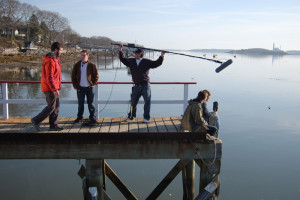It’s All About Story
Writer/director Nick Brennan’s latest film, A Marine’s Guide to Fishing, focuses on a Marine veteran struggling with both physical wounds and PTSD when he returns to his former life. “I was drawn to the story first and foremost by the realization that I couldn’t count a single close friend of mine that had served in Iraq or Afghanistan. It was a pretty sad realization given how long the wars had been going on.”

Filming A Marine’s Guide…
Brennan also thought this wasn’t unusual for many civilians today. His insight led him to use his senior thesis film (he attended NYU’s Tisch program) to explore the stories of young veterans.
“I was also interning with the investigative unit at ABC News at the time,” Brennan says, “and ended up covering a few big stories on Afghanistan, which gave me another insight into the war.” After a lot of time spent talking with vets, and with considerable research, Brennan zeroed in on the issues of PTSD and the process of reintegration into society.
Writing the Script
Brennan spent six months researching and writing the script. “Because I was a soft-handed film student with no real military experience,” he says, “I knew from the beginning of the process that for the film to really speak to something true, I needed to hear the stories of young veterans.” He worked mostly through the veteran communities at Columbia and NYU, where he interviewed two dozen student vets over the course of several months about their experiences since coming home.

Nick Brennan
Brennan’s background and experience had been primarily in journalism. He says it was a no-brainer to just start reporting the story like he was writing a news article.
“After listening to all these stories, I started drafting the film. It went through 14 different drafts (I was writing the script as part of a screenwriting class at NYU). Getting notes on the script back from class members and also the veterans I had met through researching, I ended up, by draft 14, settling on the script that more or less ended up on screen a year and a half later.”
A Shared Experience
“The sense of coming home after going through a life changing experience is something I think many of us can relate to,” Brennan says. “How do you come back to a place that has remained the same while you have changed so much?”
Brennan believes this subject that isn’t just limited to veterans. This Marine’s story speaks also to the larger public. He says he recently received an email from a 9/11 survivor who said the story in A Marine’s Guide to Fishing very much reminded her of her own experience coping with her trauma after the 9/11 attacks. “This sort of shared experience is what I was really trying to capture.”
Casting
At the time Brennan began casting for his film, veteran Matthew Pennington was struggling with his own reintegration into civilian life. Pennington lost a leg during his third tour of duty in the Middle East. His life back home was marked with isolation, heavy drinking, and depression. His relationship with his wife was at risk.
A friend sent him a casting notice. An undergraduate filmmaker was looking for someone to play a combat veteran who had lost a leg, had post-traumatic stress disorder and lived in Maine. Pennington, who has been profiled in a New York Times article, said “I thought acting would be so out of the normal that it would force me to deal with things. I wanted my life back.”
When Brennan, also a Maine native, interviewed Pennington, he realized the similarities between the real soldier and his lead character, a Marine named Connor. “Both had worked in boat repair shops, both loved to fish, both struggled with life in small-town Maine.” Brennan cast Pennington for the role.
Directing Non-Actors

A Marine’s Guide to Fishing
On set Brennan felt working with the professional SAG actors was a bigger challenge than working with Pennington. “With Matt,” he says, “it was about trust and honesty between the both of us, and creating an environment where he felt safe to expose himself and go to these dark places he’d kept bottled up inside.”
A huge part of creating this environment was making sure the crew was on the same page about keeping the set a safe and fun place. “This tone was set first by me, the producer, the AD and the Cinematographer, and then continued all the way through to the production assistants.”
Once that environment was established, the set of about 25 people all became quite close, he says. That made Matt (and also the non-actor who was cast in the role of Matt’s Staff Sergeant) feel comfortable with the work they needed to do.
Directing the Staff Sergeant role became Brennan’s biggest challenge. A former Marine Corps drill sergeant initially cast to play the role had to pull out at the last minute. That left three days to cast someone in this critical role. “A neighbor of mine in Maine, Brett Cox, was a former LAPD cop who had trained with the Navy SEALS,” Brennan says, “and had been interested in helping out in some way with the film.
“I brought a pack of beer over to his place and through the course of the night talked him into actually acting in the film. When it came time for his scene, we had only 30 minutes to rehearse this climactic moment between two non-actors, which is insane.
“I talked to the film’s AD, Andrew Geller (a phenomenally talented AD and director – he was the superhero of the production) and said I needed to clear set and have time alone with the two actors. Andrew, to his credit, recognized the importance of the scene to the film and, despite the fact that we were about an hour behind at that point, gave me the time needed to get the actors ready.”
On Set
Brennan says that, as a first-time fiction director, it was a huge challenge figuring out how to get the two non-actors to deliver a really difficult performance. “I ended up doing it by acting alongside Brett – in a way mirroring his level of excitement. This allowed him to feel comfortable.” Brennan says they kept the cameras rolling and didn’t have a set series of actions/cuts, allowing the moments to be fluid. This approach “… got Brett to the level where he could deliver the terrifying performance he gave. He did a hell of job capturing the scene and I think really made the film come together.”
Brennan teamed with DP Matthew Troy, a recent NYU Film grad who also works professionally as a gaffer. “That was a big attraction to me because I wanted a no-nonsense, professional set.” Brennan says that Troy knew what he wanted and exactly how to get it. “I couldn’t imagine a more humble and on-point DP to have on set, especially given the sensitivity of the production.” Also a volunteer firefighter and EMS, Troy turned out to be a huge resource from a safety perspective (especially with the water scenes).
Troy owned a Sony EX3 camera, to which they added a 35mm adaptor. “I wanted a filmic look to the image, capturing the grittiness of the docks and the warehouses, but I also wanted the flexibility to roll long, improvised takes with the non-actors without the time-pressure that shooting rolls of film creates.”
Edit process
When shooting was complete, Brennan initially worked with an assistant editor to go through the footage and get everything organized. He then moved back to Maine from New York for several months and edited the film himself. “I work professionally as a doc editor, so it was an exciting opportunity to cut my teeth on a narrative film.” Brennan says a solo edit is a very difficult process because you’re so close to the material that you miss having that second person in the room. As a result the film ends up weaker for it. “I don’t think I’ll ever be cutting my own films again.”
Financing
Brennan and his producer, John Logan Pierson, used Kickstarter to raise the initial cash needed. “Kickstarter was great for a film like this,” he says, “where it’s a topical issue and the Kickstarter message spread out pretty far.” A third of the financing on Kickstarter ended up coming from people he’d never met before.
He also partnered with a Swiss-based production company called DecemberProd that came on board with additional funding. A grant from NYU and a fellowship from the Moving Picture Institute helped cover post-production expenses.
Career advice
While still in high school, Brennan spent a summer at a small film school in Prague, Czech Republic, called the PCFE Film School. “It offered me professional level experience making a short film. It was also a really awesome place to be when you’re 17.” This gave him a strong portfolio when applying to college film schools.
“There’s really no one set path into Tisch,” Brennan says. He thinks most students that got into Tisch had done some sort of filmmaking program in high school. Many other students did NYU’s high school program or classes with NYFA.
“More important than any specific film program (which can often be quite expensive), is to focus on telling stories and having a portfolio that highlights your ability to tell really interesting and effective stories.” He says that seems to be the big thing NYU is looking for in their recruitment. “You can be taught the technical skills, but the ability to tell a story is a special skill that can set you apart in the college process.”
NYU isn’t the only game in town, says Brennan. Some of his favorite filmmakers to work with at Tisch were transfer students – people that started out at different schools and ended up transferring in after a year or two at another school. “I found that transfer students are some of the most focused and prepared students in the program. The transferring track, I think, can be a helpful avenue for aspiring young filmmakers that might not have the portfolio ready by the end of high school.”
Trailer for A Marine’s Guide to Fishing.
Nick Brennan’s previous short documentary film Hard Rock Havana, a documentary about a heavy metal band from Cuba, premiered at the 2010 Tribeca Film Festival.
